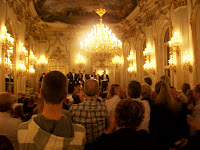 I argued that smiles were fairly universal but Lisa told me a story which her Spanish professor shared with their class. When he visited New York City he was surprised how many women smiled at him. In Spain, smiles often communicate a sexual invitation.
I argued that smiles were fairly universal but Lisa told me a story which her Spanish professor shared with their class. When he visited New York City he was surprised how many women smiled at him. In Spain, smiles often communicate a sexual invitation. With that information, and without the language skills necessary for conversation, I sat back and observed the Austrians around me. When a young toddler in a stroller smiled at me, I waved to him. His chubby hand opened and closed in imitation and his parents smiled at me.

A Viennese mother shooed her children away from a seat on a tram, wrinkling her nose in disgust and pantomimed putting her finger down her throat. Anyone watching could tell that without a word, she was telling her brood that there was vomit on the floor. I smiled and nodded at her--having already made the same discovery. Another mother squared her children's shoulders and ushered them to the place where she wanted them to stand to wait for the train. Without a word, she told them exactly what she expected.
In a small, crowded restaurant in Nuremberg, Germany, an elderly gentleman asked if he could join our table. He didn't say a word--his gesture and quizzical look communicated his question. Only later on in our meal when he saw my husband pouring over the city map did he ask, "Could I be of some help?" and we realized that he spoke English!
In Tabor, a small town in the Czech Republic, our family took a tour through underground tunnels that alternately served as storage for home-brewed beer and prisons. Our tour included a group of middle schools students who laughed and pointed at each other as we all donned white plastic helmets to protect our heads against the low ceilings. Although we couldn't understand a word they were saying, their message to one another was clear.
Spankings, kisses, hugs, raised eyebrows, a shrug that says "I don't know" --these are all part of universal non-verbal language.

Other languages also spoke to me. One night in Vienna we heard opera in the Hall of Mirrors where, at the age of 6 in 1762, Mozart performed for Empress Maria Theresia (Marie Antionette's mother.) Although none of the performance was in English, the body language of the singers helped convey the stories they were singing. The music itself, composed by Strauss and Mozart, was its on language without words-- bringing me to tears as I remembered my father's love for classical music.

In a similar vein, the paintings and sculptures that bedeck roofs, churches, and doorways throughout Austria, Germany, and the Czech Republic each tell a story. This picture shows a medieval painting that had been stuccoed over in a cathedral in Salzburg.

This sculpture crowned the Gloriette, Maria Theresia's "summer home."


I never tired of the beautiful frescoes on the buildings' exteriors. These were both in the Czech Republic.


In Prague, before they begun to number the houses, they used pictures over the doorways like this, to identify the homes.

Sculptures were common in large cities or small towns.


Lisa loved this unicorn, near the steps where Maria and the Van Trapp children sang the "Do, Re, Mi" song in the Sound of Music.

Although my lack of German or Czech language skills did keep me in an "American bubble," I respectfully disagree with Lisa and Courtney--there are languages that speak across cultures. But, when I visit Spain next year when my other daughter Lori is studying there, I will take Lisa and Courtney's advice to heart. I'll be careful who I choose to smile at.
>Technorati Tags:
Austria, Mozart, nonverbal communication, smiles, Sound of Music, appreciating Europe




3 comments:
How interesting--I love your observations about language!
Lovely tour! Thanks. I think we Americans mystify Europeans with all the smiling. In some places it makes us seem not trustworthy.
And being southern just amplifies our tendencies! Didn't call anyone "honey", did you?
Nice use of pics!! Yay!
Thanks ladies, for stopping by. No, Joyce, I didn't call anyone "honey."
I'm learning about pic use from the best teacher ever. but boy, it takes time! Maybe I'll get the hang of it eventually-- at least I can cut and paste now!
Post a Comment